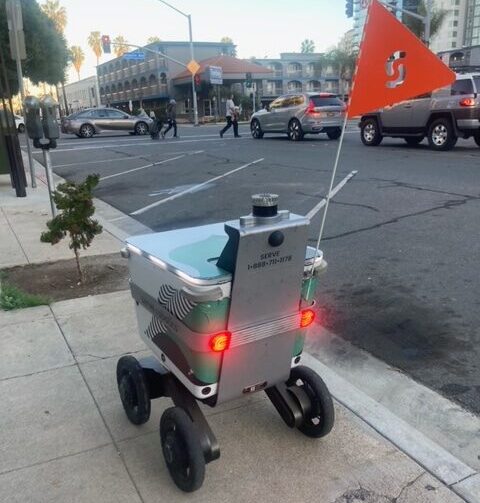
Long Beach has temporarily kicked out delivery robots that at least one company was testing while the city figures out how to license and regulate them.
For several months, Serve Robotics was testing the automated bots to deliver Uber Eats, but Long Beach asked them to pause in April, according to the company.
A city spokesperson confirmed this, saying staffers told Serve Robotics they needed a business license to operate, but Long Beach does not have a licensing process for automated delivery services.
Serve Robotics complied with the request because “delivery robots don’t fit neatly into the city’s existing business license categories,” said Aduke Thelwell, a company spokesperson.
This comes not long after a downtown Long Beach resident wrote to Councilmember Mary Zendejas’ office in January about a “strange encounter” she had with one of Serve’s robots. The resident said the robot blared a siren and emitted flashing red lights when she momentarily blocked its path while she was out walking with a group of friends. While she wasn’t opposed to the robots, the resident asked the city to make sure it had a way to ensure they were operating safely.
Since late February, three city departments have been working to craft a program that properly regulates the robots. In that time, the city has “moved from exploration to development” with the goal of launching a “small-scale pilot program later this year,” city spokesperson Jen De Prez wrote.
Once that pilot program concludes, city staff will make adjustments before considering a full program, De Prez wrote. The pilot program will help determine how many operators can be licensed and where they can operate in the city.
Serve Robotics first launched in Los Angeles in 2019. The company inked a deal with Uber Eats in July 2023 and has since expanded to Atlanta, Miami, Houston and Dallas-Fort Worth.

The company said its four-wheeled robots — with names like Otto, Luna or Snack-E — use three cameras, GPS and artificial intelligence to navigate sidewalks. They use crosswalks on their own and brake to avoid collisions with cars coming out of parking lots, but they also have a human operator supervising their movements, Thelwell said.
Most deliveries range between a mile and a mile-and-a-half, according to the company. The robots have a maximum speed between 7 and 11 mph, depending on the model.
